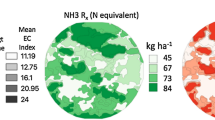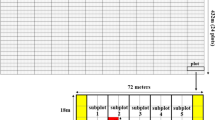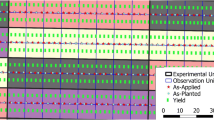Abstract
The objectives of this article are to examine the practicality of on-farm precision experiments to sufficiently lower the costs of acquiring the information necessary to make site-specific nitrogen (N) fertilizer management profitable, and to examine the potential value of on-farm precision experiments in uniform rate N fertilizer management. After presenting a simple economic model as theoretical background, two hypotheses are tested. Hypothesis 1 is that if on-farm precision experiments are conducted over sufficiently many growing seasons on a “flat and black” central Illinois cornfield, the information gained can be used to make site-specific N application management more profitable than uniform rate N application management. Hypothesis 2 is that conducting on-farm precision experiments on that field for only a few years will provide information that can increase profits for a farmer who otherwise would follow the N application rate recommendation of the Maximum Return to Nitrogen project. Monte Carlo simulations rejected Hypothesis 1, but failed to reject Hypothesis 2. On the modeled central Illinois field, which was characterized by relatively little spatial heterogeneity, even fifteen years of on-farm precision experiments did not provide enough information to make using site-specific N management profitable. But the information gleaned from just a few years of on-farm precision experiments provided very profitable information to improve spatially uniform N rate management.





Similar content being viewed by others
References
Arundel, S. T., Archuleta, C. M., Phillips, L. A., Roche, B. L., & Constance, E. W. (2015). 1-meter digital elevation model specification. U.S. Geological Survey Techniques and Methods. https://doi.org/10.3133/tm11B7.
Bullock, D. S., Boerngen, M., Tao, H., Maxwell, B. D., Luck, J. D., Shiratsuchi, L., et al. (2019). The data-intensive farm management project: Changing agronomic research through on-farm experimentation. Agronomy Journal, 111, 725–735.
Bullock, D. G., & Bullock, D. S. (1994). Quadratic and quadratic-plus-plateau models for predicting optimal nitrogen rate of corn: A comparison. Agronomy Journal, 86(1), 191–195.
Bullock, D. S., & Bullock, D. G. (2000). From agronomic research to farm management guidelines: A primer on the economics of information and precision technology. Precision Agriculture, 2(1), 71–101.
Bullock, D. G., Bullock, D. S., Nafziger, E. D., Peterson, T. A., Carter, P. R., Doerge, T. A., et al. (1998). Does variable rate seeding of corn pay? Agronomy Journal, 90(6), 830–836.
Bullock, D. S., Lowenberg-DeBoer, J., & Swinton, S. M. (2002). Adding value to spatially managed inputs by understanding site-specific yield response. Agricultural Economics, 27(3), 233–245.
Bullock, D. S., Ruffo, M. L., Bullock, D. G., & Bollero, G. A. (2009). The value of variable rate technology: An information-theoretic approach. American Journal of Agricultural Economics, 91(1), 209–223.
Cerrato, M. E., & Blackmer, A. M. (1990). Comparison of models for describing: Corn yield response to nitrogen fertilizer. Agronomy Journal, 82(1), 138–143.
Conrad, O., Bechtel, B., Bock, M., Dietrich, H., Fischer, E., Gerlitz, L., et al. (2015). System for automated geoscientific analyses (SAGA) v 214. Geoscientific Model Development, 8(7), 1991–2007.
Cook, S. E., Adams, M. L., & Corner, R. J. (1999). On-farm experimentation to determine site-specific responses to variable inputs. In P. C. Robert, R. H. Rust, & W. E. Larson (Eds.), Precision agriculture (pp. 611–621). Madison, WI: American Society of Agronomy.
Day, R. H. (1965). Probability distributions of field crop yields. Journal of Farm Economics, 47(3), 713–741.
Heady, E. O., & Pesek, J. (1954). A fertilizer production surface with specification of economic optima for corn grown on calcareous Ida silt loam. Journal of Farm Economics, 36(3), 466–482.
Hoeft, R. G., & Peck, T. R. (2007). Soil testing and fertility. In R. G. Hoeft & E. Nafziger (Eds.), Illinois agronomy handbook (pp. 91–131). Urbana-Champaign, IL: Department of Crop Sciences.
Iowa State University Agronomy Extension and Outreach. (2019). Corn nitrogen rate calculator. Retrieved July 2019, from https://cnrc.agron.iastate.edu/.
Kapoor, M., Kelejian, H. H., & Prucha, I. R. (2007). Panel data models with spatially correlated error components. Journal of Econometrics, 140(1), 97–130.
Laffont, J. J. (1989). Economie de l'incertain et de l'information (the economics of uncertainty and information). Cambridge, MA: MIT Press.
Marenya, P. P., & Barrett, C. B. (2009). State-conditional fertilizer yield response on western Kenyan farms. American Journal of Agricultural Economics, 91(4), 991–1006.
Millo, G., & Piras, G. (2012). splm: Spatial panel data models in R. Journal of Statistical Software, 47(1), 1–38.
Nafziger, E. (2018). N Rate Calculator Updated. The Bulletin. University of Illinois Extension. Retrieved July 2019, from https://bulletin.ipm.illinois.edu/?p=4095.
QGIS Development Team. (2019). QGIS Geographic Information System. Open Source Geospatial Foundation Project. Retrieved July 2019, from https://qgis.osgeo.org.
Rodriguez, D. G. P., Bullock, D. S., & Boerngen, M. A. (2019). The origins, implications, and consequences of yield-based nitrogen fertilizer management. Agronomy Journal, 111(2), 725–735.
Ruffo, M. L., Bollero, G. A., Hoeft, R. G., & Bullock, D. G. (2005). Spatial variability of the Illinois soil nitrogen test. Agronomy Journal, 97(6), 1485–1492.
Ruffo, M. L., Bollero, G. A., Bullock, D. S., & Bullock, D. G. (2006). Site-specific production functions for variable rate corn nitrogen fertilization. Precision Agriculture, 7(5), 327–342.
Rund, Q. (2000). Enhanced farm research analyst: Tools for on-farm crop production research. 20th Annual ESRI International User Conference. San Diego,CA:ESRI. Retrieved July 2019, from https://citeseerx.ist.psu.edu/viewdoc/summary?doi=10.1.1.138.3728.
Sawyer, J., Nafziger, E., Randall, G., Bundy, L., Rehm, G., & Joern, B. (2006). Concepts and rationale for regional nitrogen rate guidelines for corn. Ames, IA: Iowa State University-University Extension. Retrieved July 2019, from https://publications.iowa.gov/id/eprint/3847.
Stauber, M. S., Burt, O. R., & Linse, F. (1975). An economic evaluation of nitrogen fertilization of grasses when carry-over is significant. American Journal of Agricultural Economics, 57(3), 463–471.
Tembo, G., Brorsen, B. W., Epplin, F. M., & Tostão, E. (2008). Crop input response functions with stochastic plateaus. American Journal of Agricultural Economics, 90(2), 424–434.
U.S. Geological Survey. (2017). 1 meter digital elevation models (DEMs)—USGS National Map 3DEP downloadable data collection. Retrieved July 2019, from https://www.usgs.gov/core-science-systems/ngp/3dep.
Acknowledgments
Our research was supported in part by an award from the USDA NIFA Agricultural and Food Research Initiative’s Food Security Challenge Area program, Award Number 2016-68004-24769, by USDA NIFA’s Hatch Project 470-362, and by a Future Interdisciplinary Research Explorations Seed Grant from the University of Illinois College of Agriculture, Consumer, and Environmental Studies. The authors thank Anabelle Couleau, and Sooin Yun for outstanding research assistance, and Caitlin McGuire for editorial assistance.
Author information
Authors and Affiliations
Corresponding author
Additional information
Publisher's Note
Springer Nature remains neutral with regard to jurisdictional claims in published maps and institutional affiliations.
Rights and permissions
About this article
Cite this article
Bullock, D.S., Mieno, T. & Hwang, J. The value of conducting on-farm field trials using precision agriculture technology: a theory and simulations. Precision Agric 21, 1027–1044 (2020). https://doi.org/10.1007/s11119-019-09706-1
Published:
Issue Date:
DOI: https://doi.org/10.1007/s11119-019-09706-1




